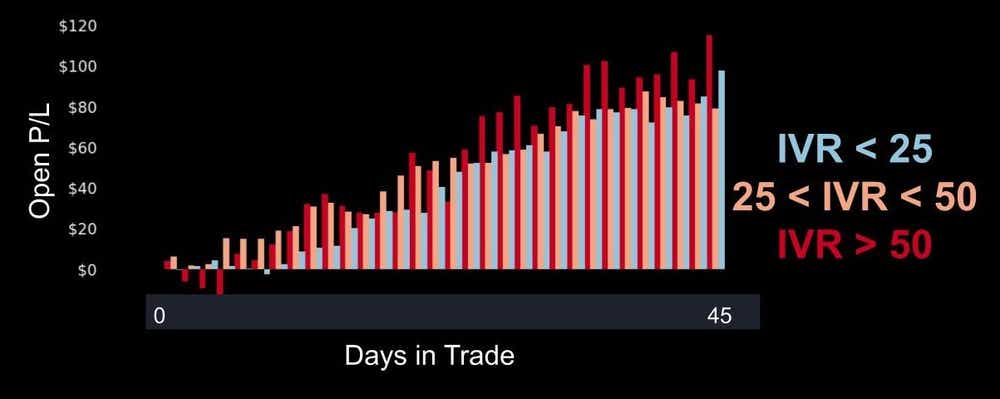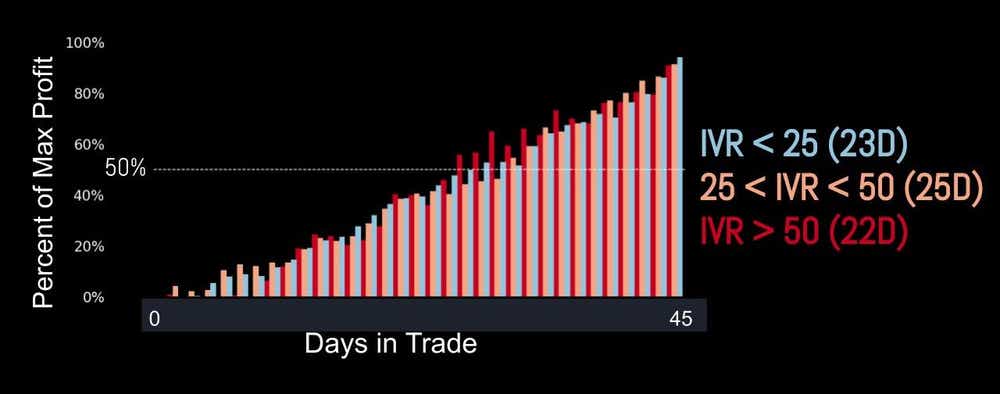Does High IV Mean Quick Profits?

Does High IV Mean Quick Profits?
By:Kai Zeng
For options premium sellers, entering trades when the implied volatility level is high can be a strategic move
- High volatility can work in a trader's favor.
- The influence of IV on trade management is equally significant.
- A higher IV rank produces greater trade credit and higher profits.
For options premium sellers, entering trades when implied volatility (IV) is high can be a strategic move.
The reason is higher IV typically translates to more expensive options premiums. For instance, a one-standard-deviation (1SD) strangle on the SPDR S&P 500 ETF Trust (SPY) can be 25% more lucrative when the IV rank (IVR) sits between 25 and 50, as opposed to lower IVR levels.
Furthermore, when the IVR exceeds 50, the premium jumps to 44% more expensive, offering an enticing proposition for traders aiming to maximize their credit from the options sold.

Trade management and IV
The influence of IV on trade management is equally significant. Traders often set a goal of managing or closing their positions once they've captured 50% of the maximum potential profit. It takes an average of 23 trading days to reach this 50% threshold for a 1SD Strangle, which is akin to managing trades at roughly 21 days to expiration (DTE) in a 45-day cycle.
Does a higher level of IV help in reducing the holding duration to reach the same profit target? An analysis of 45 DTE SPY 1SD Strangles over a 45-day cycle reveals some intriguing insights. Trades with a high IVR have a greater profit/loss (P/L) and exhibit higher volatility. However, managing winners at the 50%-mark results in a better daily P/L and lower volatility.

The daily analysis underscores that high IVR trades churn out a higher daily P/L throughout the expiration cycle. Yet, regardless of the IV Rank, strangles tend to reach profit targets, such as 50% of the maximum profit, in a similar number of days. This suggests the average duration remains consistent, comparable to managing trades at 21 DTE.

A higher IV rank produces higher profits
The results are simple, but the key takeaways for traders are insightful. A higher IV rank produces greater trade credit and higher profits, but also introduces higher volatility into the equation.
Despite this increased volatility, the period to reach 50% in profits remains relatively unchanged across different IV levels. This means traders who exit positions at certain percentage of the maximum profit point, mostly 50%, don’t need to worry too much about the remaining days to expiration. Consequently, over the long-term traders have the flexibility to exit positions at 21DTE, resulting in a similar trading duration.
Kai Zeng, director of the research team and head of Chinese content at tastylive, has 20 years of experience in markets and derivatives trading. He cohosts several live shows, including From Theory to Practice and Building Blocks. @kai_zeng1
For live daily programming, market news and commentary, visit tastylive or the YouTube channels tastylive (for options traders), and tastyliveTrending for stocks, futures, forex & macro.
Trade with a better broker, open a tastytrade account today. tastylive, Inc. and tastytrade, Inc. are separate but affiliated companies.
Options involve risk and are not suitable for all investors. Please read Characteristics and Risks of Standardized Options before deciding to invest in options.
tastylive content is created, produced, and provided solely by tastylive, Inc. (“tastylive”) and is for informational and educational purposes only. It is not, nor is it intended to be, trading or investment advice or a recommendation that any security, futures contract, digital asset, other product, transaction, or investment strategy is suitable for any person. Trading securities, futures products, and digital assets involve risk and may result in a loss greater than the original amount invested. tastylive, through its content, financial programming or otherwise, does not provide investment or financial advice or make investment recommendations. Investment information provided may not be appropriate for all investors and is provided without respect to individual investor financial sophistication, financial situation, investing time horizon or risk tolerance. tastylive is not in the business of transacting securities trades, nor does it direct client commodity accounts or give commodity trading advice tailored to any particular client’s situation or investment objectives. Supporting documentation for any claims (including claims made on behalf of options programs), comparisons, statistics, or other technical data, if applicable, will be supplied upon request. tastylive is not a licensed financial adviser, registered investment adviser, or a registered broker-dealer. Options, futures, and futures options are not suitable for all investors. Prior to trading securities, options, futures, or futures options, please read the applicable risk disclosures, including, but not limited to, the Characteristics and Risks of Standardized Options Disclosure and the Futures and Exchange-Traded Options Risk Disclosure found on tastytrade.com/disclosures.
tastytrade, Inc. ("tastytrade”) is a registered broker-dealer and member of FINRA, NFA, and SIPC. tastytrade was previously known as tastyworks, Inc. (“tastyworks”). tastytrade offers self-directed brokerage accounts to its customers. tastytrade does not give financial or trading advice, nor does it make investment recommendations. You alone are responsible for making your investment and trading decisions and for evaluating the merits and risks associated with the use of tastytrade’s systems, services or products. tastytrade is a wholly-owned subsidiary of tastylive, Inc.
tastytrade has entered into a Marketing Agreement with tastylive (“Marketing Agent”) whereby tastytrade pays compensation to Marketing Agent to recommend tastytrade’s brokerage services. The existence of this Marketing Agreement should not be deemed as an endorsement or recommendation of Marketing Agent by tastytrade. tastytrade and Marketing Agent are separate entities with their own products and services. tastylive is the parent company of tastytrade.
tastyfx, LLC (“tastyfx”) is a Commodity Futures Trading Commission (“CFTC”) registered Retail Foreign Exchange Dealer (RFED) and Introducing Broker (IB) and Forex Dealer Member (FDM) of the National Futures Association (“NFA”) (NFA ID 0509630). Leveraged trading in foreign currency or off-exchange products on margin carries significant risk and may not be suitable for all investors. We advise you to carefully consider whether trading is appropriate for you based on your personal circumstances as you may lose more than you invest.
tastycrypto is provided solely by tasty Software Solutions, LLC. tasty Software Solutions, LLC is a separate but affiliate company of tastylive, Inc. Neither tastylive nor any of its affiliates are responsible for the products or services provided by tasty Software Solutions, LLC. Cryptocurrency trading is not suitable for all investors due to the number of risks involved. The value of any cryptocurrency, including digital assets pegged to fiat currency, commodities, or any other asset, may go to zero.
© copyright 2013 - 2025 tastylive, Inc. All Rights Reserved. Applicable portions of the Terms of Use on tastylive.com apply. Reproduction, adaptation, distribution, public display, exhibition for profit, or storage in any electronic storage media in whole or in part is prohibited under penalty of law, provided that you may download tastylive’s podcasts as necessary to view for personal use. tastylive was previously known as tastytrade, Inc. tastylive is a trademark/servicemark owned by tastylive, Inc.